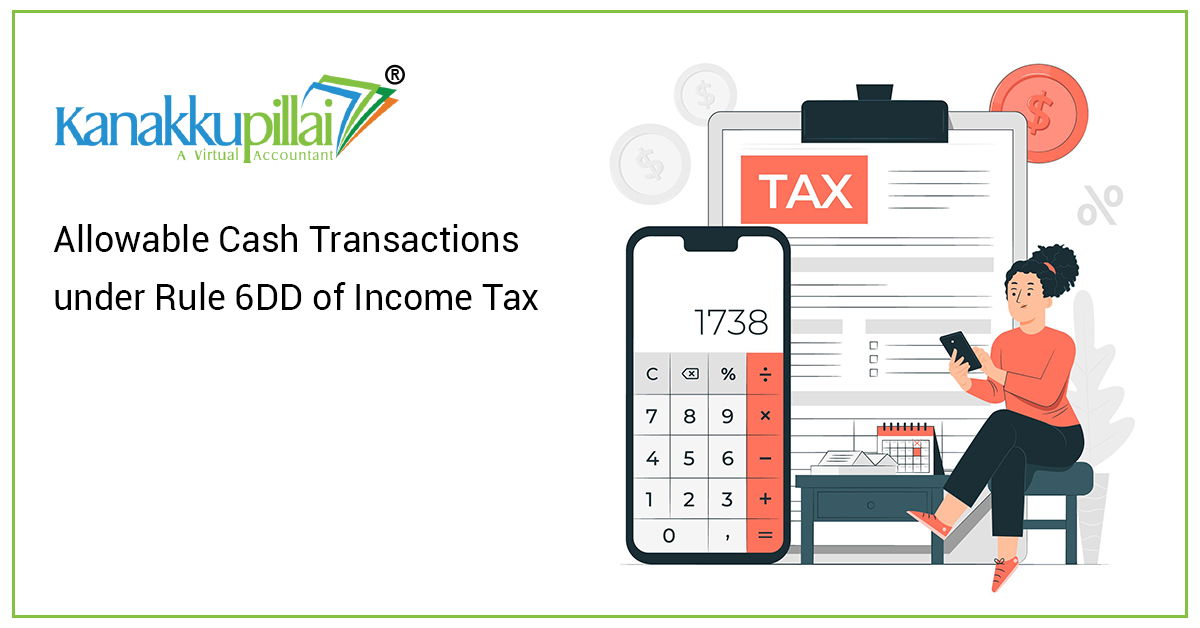The Indian Economy today is shifting to a cashless and digitized economy. This is because electronic transactions tend to give a proper trail for transactions providing a clear money trail and thereby making it difficult for the tax evaders to not just evade tax but also remit their transactions using black money and thereby reduce the same.
Law, generally, does not have any restrictions for payment of cash for transactions of purchase/sale of jewellery or immovable property, etc., but if the value of a single transaction exceeds two lakhs, then the seller is prohibited from accepting any cash beyond two lakhs for such transactions. The Income Tax Act restricts cash transactions if the aggregate value or amount involved in the same exceeds a certain limit prescribed by the Income Tax Act through section 40A(3).
The income tax rule 6DD which deals with cases and circumstances in which a payment or aggregate of payments exceeding Rs 20,000 may be made to a person in a day, otherwise than by an account payee cheque drawn on a bank or account payee bank draft, has been amended.
Section 40(A)(3) and 40(A)(3A) of the Income Tax Act
40(A)(3)
As per section 40A(3) of the Income Tax Act, if an assessee incurs any expense in respect of which a payment or aggregate of payments was made to a person during a day, by way of cash other than by account payee cheque drawn on a bank or account payee draft or use of an electronic clearing system through a bank account or such other electronic mode which may be prescribed as per the law, and the same exceed INR 10,000, expenditure shall not be allowed as deduction.
For example, say a bill for expenditure with regard to delivery of materials was raised on 10th August 2021, amounting to INR 25,000. The same was paid by the taxpayer on the 15th of August 2021, and for the same to be allowed as an expenditure, then the payment should be made through the account payee cheque, account payee draft, or ECS. If the same is done in whole as a cash transaction, i.e., INR 25,000, it would exceed the allowed limit of INR 10,000, making the same disallowed u/s 40(A)(3).
Section 40(A)(3A)
Further, section 40A(3A) states that in case of any payment being made in subsequent years with regard to an expense for which deduction was claimed in an earlier year on a due basis, then the payment made with regard to such expenditure is in excess of INR 10,000 and not made by account payee cheque, account payee draft or electronic clearing system, then the payment shall be deemed as income under the head Income From Business or Profession for the previous year in which such payment was made by the taxpayer.
It shall also be noted that, in case of payment made for expenditure with regard to plying, hiring, or leasing goods carriage, the provisions of section 40(A)(3)/(3A) shall have effect with the INR 10,000 substituted by INR 35,000.
Taking reference to the above example, say the bill of INR 25,000 was pertaining to 10th August 2020, and the same was claimed as a deduction when filing the return of income for the FY 2020-21. But the payment for the bill was made on the 15th of August 2021. The same should be made using an account payee cheque, account payee draft, or electronic clearing system (ECS), and if the same is made in cash, then it shall be deemed as income under the head Income from Business or Profession and taxed during the FY 2021-22 as it exceeds the limit specified by the Income Tax Act which is INR 10,000.
And if the same is with respect to the hiring of goods carriage, then it shall not be deemed as an income, because the total bill amount is INR 25,000 and the same is below INR 35,000.
And in case of payments which are made on a single day, then the aggregate payments made to a single person on a single day against one bill exceeds INR 10,000 then such expenditure disallowed under this section, in such cases and circumstances as may be prescribed, having regard to the banking facilities available and the expediency of the business and such other relevant factors.
Taking virtue of the same example, say the bill amounting to INR 25,000 was paid in 3 different payments say two different payments of INR 10,000 and one payment of INR 5,000 making a total or aggregate of INR 25,000 against the same bill, to a single person on a single day. Due to this reason, the same expenditure of INR 25,000 would be disallowed under this section thereby increasing the taxable profit of the entity.
Exceptions to 40A(3) and 40(A)(3A)
The Income tax return filing online through Rule 6DD specifies cases and circumstances in which a payment or aggregate of payments exceeding INR 10,000 may be made to a person in a day through cash payment and not through account payee cheque, account payee draft or ECS, or such other electronic mode as prescribed by 6ABBA. This includes the following:
(a) The payment is made to:
(i) RBI or Reserve Bank of India,
(ii) SBI or State Bank of India,
(iii) Any co-operative bank or land mortgage bank,
(iv) any primary agricultural credit society or any primary credit society,
(v) the Life Insurance Corporation of India.
(b) The payment is made to the Government, and the same is made under the rules framed by it and is to be remitted in cash.
(c) The payment is made in specified modes like:
(i) a letter of credit (LOC) arrangement through a bank,
(ii) a mail or telegraphic transfer through a bank,
(iii) a book adjustment from any account in a bank to any other account in that or such other bank (say through electronic modes or debit card or credit card),
(iv) a bill of exchange made payable only to the bank,
(d) The payment is made by the payer by way of making adjustments against the amount of liability, which was incurred by the payee for any goods supplied or services rendered by the assessee to such payee,
(e) The payment has been made for the purchase of:
(i) agricultural or forest produce, or
(ii) produce of animal husbandries like livestock, meat, skins, and hides or dairy or poultry farming, or
(iii) fish or fish products, or
(iv) the products of horticulture or apiculture,
to the cultivator, grower, or producer of such articles, product, or products,
(f) Payment is made for purchasing the products manufactured or processed without the aid of power in a cottage industry to the producer of such products,
(g) When the payment is made in a village or town to a person who is carrying on business or is residing in a village or town which does not have such facilities of the bank as on the date of such payment,
(h) When payment is made to an employee of the assessee or legal heir of such employee in connection with the retirement, retrenchment, resignation, discharge, or death of such an employee in the form of gratuity, retrenchment compensation, or such similar terminal benefit and the aggregate of such payments to both employee or legal heir does not exceed INR 50,000,
(i) The payment when made to an employee by way of salary after deducting the Income Tax pertaining to section 192 and
– such employee has been temporarily posted for a continuous period of 15 days or more in a place that is different from his or her normal place of duty or is on a ship and
– such employee does not maintain any account in any bank at such place of temporary employment or on the ship.
(j) When the payment is made by the taxpayer to the agent who is required to make the payment to such other third party for the goods and services provided in the name of the taxpayer or assessee.
(k) A payment that is made by an authorized dealer or a money changer against the purchase of foreign currency or travellers’ cheques in the normal course of business.





